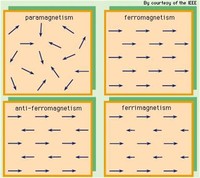Facts about Magnetism

James Clerk Maxwell (1831-1879) added another term to Ampиre's equation, mathematically developed Faraday's concept of force fields, and summarized the relationship between electricity and magnetism in a set of equations named after him.

Ferromagnetism is the "normal" form of magnetism that most people are familiar with, as exhibited by refrigerator magnets and horseshoe magnets.

The physical cause of the magnetism of an object—as distinct from the production of magnetic fields by electrical currents—is attributed to the "magnetic dipoles" of the atoms in the object.

The overall phenomenon came to be called electromagnetism, and the combination of electric and magnetic fields was called the electromagnetic field.

Diamagnetism is a form of magnetism exhibited by a substance only in the presence of an externally applied magnetic field.

The phenomenon of magnetism has been known since ancient times, when it was observed that lodestone, an iron oxide mineral (Fe3O4) with a particular crystalline structure, could attract pieces of iron to itself.

Paramagnetism is based on the tendency of atomic magnetic dipoles to align with an external magnetic field.

Some of the different types of magnetism are: diamagnetism, paramagnetism, ferromagnetism, ferrimagnetism, and antiferromagnetism.

Such naturally occurring magnets were used in the early experiments with magnetism.
